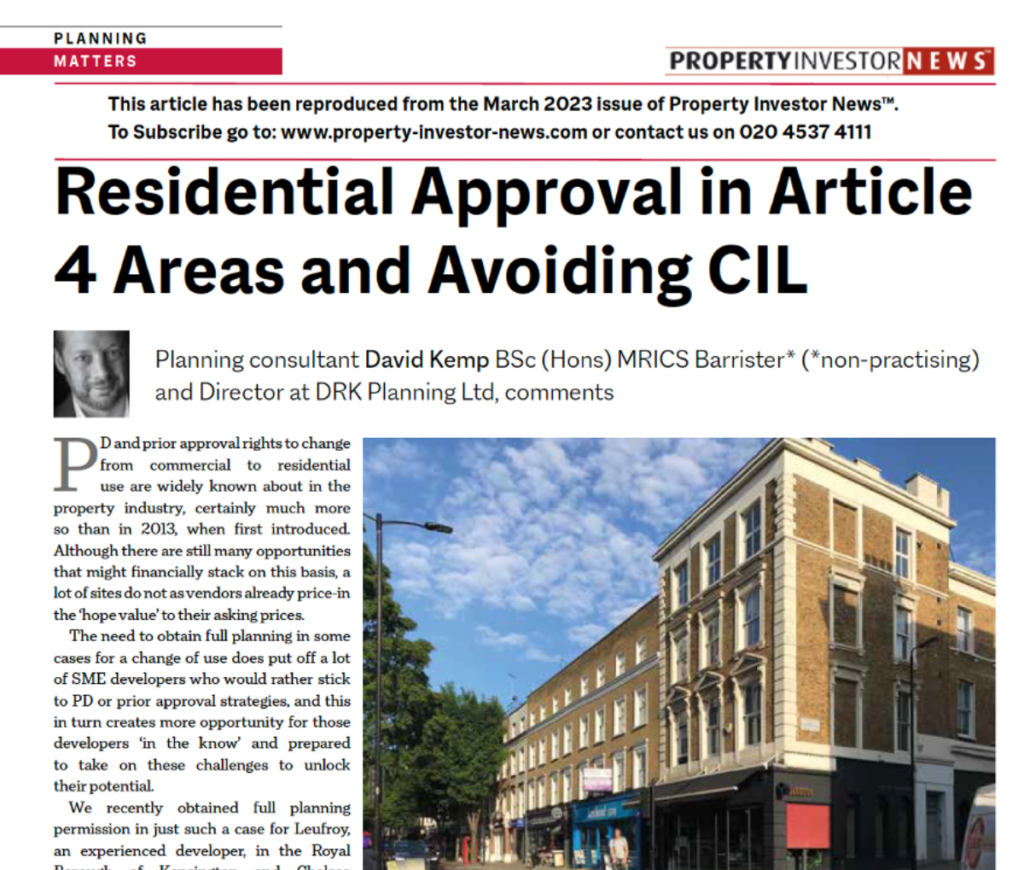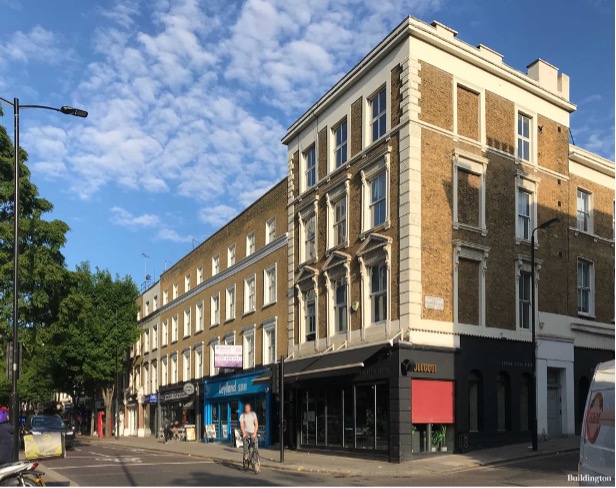
PD and prior approval rights to change from commercial to residential use are widely-known about in the property industry, certainly much more so than in 2013, when first introduced. Although there are still many opportunities that might financially stack on this basis, a lot of sites do not as vendors already price-in the ‘hope value’ to their asking prices.
The need to obtain full planning in some cases for a change of use does put off a lot of SME developers who would rather stick to PD or prior approval strategies, and this in turn creates more opportunity for those developers ‘in the know’ and prepared to take on these challenges to unlock their potential.
We recently obtained full planning permission in just such a case for Leufroy, an experienced developer, in the Royal Borough of Kensington and Chelsea (RBKC) to convert roughly 3,500 sqft of secondary office space on the upper floors of a building in Notting Hill Gate to 4no self-contained high-end apartments.

Checking for Article 4 Directions
Article 4 of the Town and Country Planning (General Permitted Development) (England) Order 2016 (‘the GPDO’) provides the legal authority for either the Secretary of State to issue a Direction under this power to withdraw PD or prior approval rights for specified changes of use. When such a Direction has been made, then prior approval or PD must be obtained before the Direction comes into force (Article 4(2)).
Therefore, if a Direction comes into force before the end of 56 days of a prior approval application, or before the agreed extension period on such an application, then the application fails automatically; even if the application was refused before 56 days expires, an appeal is submitted and the Direction comes into force before the appeal is determined.
The NPPF now sets out further tests on the use of Article 4 directions, most importantly that the Council has to be able to “robustly” justify that they are “necessary to avoid wholly unacceptable adverse impacts” and must be limited the “smallest geographical area possible” (NPPF, paragraph 53).
RBKC was instructed by the Secretary of State to amend its initial Article 4 Direction, which would have been Borough-wide, in July 2022; a power that the Secretary of State has under Schedule 3 paragraph 1(13) of the GPDO. The new Article 4 Direction still covered the application site in Notting Hill Gate. It is important when reviewing whether a site is covered by an Article 4 Direction to check the following:
- Location: is the site within the area of the direction outlined in red (a map will accompany the Direction).
- Extent of affected uses: the Direction might not extend to all uses covered by some PD rights (the London Borough of Waltham Forest made an Article 4 Direction against Class M rights but limited only to shops, so PD still remained for takeaways, betting shops and launderettes).
- Date confirmed/ immediate: for a Direction to come into force, it will have to carry two signatures – the date on which it is made and the date on which it is confirmed (e.g. see current Directions for Hackney CAZ and Waltham Forest relation to Class MA rights).
Most Article 4 Directions will not come in immediately, but might typically be made about 12 months before they come into force (but can be shorter!). However, a Council can make an Article 4 direction with immediate effect (e.g. London Borough of Merton in respect of HMOs under Class C4 from Class C3), but this has to be subject to strict requirements, will automatically expire after 6 months if not confirmed before then and the Secretary of State can modify or cancel any such Direction.
Principle of change of use
RBKC generally seeks to resist the loss of office floor space in town centres (Local Plan Policy CF5). Interestingly, the policy itself does not include any exceptions to this, such as where it is not viable to retain the office floor space. Other Councils have similarly-worded policies (e.g. Priority Office Area policies in Hackney). However, RBKC does acknowledge that a change of use to residential can be supported if the premises have been marketed for given period and there is clearly no interest in the space from potential occupiers.
Such an approach is also strongly consistent with the principles of sustainable development in the NPPF in terms of re-using under-utilised land above shops and in town centres (NPPF, Chapter 11).
The starting point should be to check the Local Plan for specific guidance as to what is needed in terms of preparing evidence to justify the case for a change of use. Some Councils, such as Islington and Lambeth provide specific guidance, which should be very closely followed.
However, where the Local Plan provides no such steer, then there are a number of key points to cover in any report, which should generally be prepared by an experienced local agent or the agent marketing the property:
- Marketing period: It should normally cover a marketing period of at least 12 months, but could be less, say 9 months, if this period will accumulate as the application progresses through planning. The method of marketing should be wide-ranging.
- Evidence of letting and sales market: the marketing should cover different possible markets for either purchase or rental and marketing over the period needs to be at levels justified by similar deals in the same area. It should also be marketed across the Class E Uses.
- Record of interest in the property and reasons for vacancy: it should set out what enquiries were received, when, a record of any follow-up and reasons why the interest was not taken further.
If the marketing report opines that the reason for the poor interest is due to the specification of the property, the report should attempt to estimate what works would be needed to meet market demand, and estimate the commercial viability of doing so.
In this case, the marketing period had to be extended to up to 3 years in total, as officers were concerned that the lack of interest in the offices during the Covid Pandemic was not representative of ‘normal’ market conditions. However, this is highly unusual and specific to the relevance of successive lock-downs.
Scoping the opportunity
Councils are frequently reluctant to allow such a change of use in Article 4 areas, given the loss of so much commercial floor space under PD. Therefore, they often set quite a high bar to the standard of proof needed. Therefore, pre-application can be a useful way of testing out the proof obtained and, if and when a full application is made, many local authorities have an informal policy not to spend time during the application to work with the applicant on short-comings to the application if there has been no pre-application first!
Our pre-application was held with RBKC in February 2021, and officers required further marketing as there was concern that periods of lock-down had undermined the strength of the marketing exercise.
Where a developer is looking at such opportunities and Prior Approval is not available, then it is best if the property is obtained either via an option or on a subject to planning basis. With so many vendors looking to sell on an unconditional basis and with residential hope value priced-in, this increases risks for buyers. However, thorough enquiries of the current agent with regard to the condition of the property and its location, typical length of marketing for offices locally and likelihood of future rental or sale of the property for office use can help to provide much more comfort before committing to such an opportunity.
Optimising potential and layout
One of the issues that the Council raised was whether we were providing enough flats in the scheme. The London Plan and the NPPF require development proposals to optimise the provision of new housing in development schemes.
We provided an alternative layout to demonstrate to the officers that this would not be possible:
Although an extra unit could be carved out of the large 3-bedroom duplex family-sized apartment by splitting this into 2 x 2-bedroom units, we referenced the following to make the case for only 4no units, which the Council accepted:
- The extra unit would lead to more circulation space a 5.3% loss in net useable area, further compounded by the additional cycle storage needed.
- The deeper and darker floor plan through reconfiguration would degrade the quality of the space and lead to poor internal natural light.
- One less unit means less disturbance to neighbours, fewer building materials and waste and more sustainable.
Beware the cost of CIL!
Due to the high cost of CIL in RBKC, the development would have led to a potential liability of over £360,000. This amount is partly due to indexation against BCIS data held by the RICS and is part of the statutory formula for calculating CIL. This formula and any exemptions or disregards is set out in the Community Infrastructure Levy Regulations 2010 (as amended).
The basis for challenging a CIL notice is very rigid and cannot usually be challenged on the basis of a lack of viability (contrast with affordable housing payments, which can be). Therefore, it is critical to know from the outset, perhaps before even buying a site the likely CIL charge (if done so with the intention to develop for housing). This is a complex area of planning and professional advice should be sought.
Fortunately, whilst preparing the application, we reviewed the CIL position. We were able to provide evidence to the Council early enough and confirm that at least part of the floor space had been occupied for at least 6 continuous months in the last 3 years. This was confirmed in the relevant CIL forms. It is important that this is done early in the application, and preferably on submission of the application to make a consistent and robust CIL-proof case to officers.
After the application was granted planning permission, the client received a CIL Liability Notice for just over £360,000. We emailed the CIL team back immediately with the information we had sent to the Planning team a couple of months earlier and the Notice was amended to £NIL. Sometimes, information does not get passed along to other Council teams.
Settling and signing the s106
A brief comment on s106 as this is probably deserving of its own article. It can take longer than you think sometimes to settle the formalities with a s106 deed (e.g. for car-free housing or affordable housing). In this case, the obligations and drafting of the deed were quite simple, but the client was registered outside the UK and, hence, the local authority needed a lawyer based in that jurisdiction (Guernsey) to confirm a number of matters relevant to the legality and enforceability of s106 covenants in the law of that region. The deed took about 2 months to prepare and complete between the parties, with permission being granted about 6 months after the submission of the application.
Conclusion
Offices in town centres of low or poor specification in Article 4 areas can put off potential rival developers but provide a great opportunity. However, there are a number of risks around the marketing and potential for retaining office use, policy impetus for optimising development and CIL liabilities. Therefore, professional advice should be sought very early on, thorough enquiries made with local agents and the marketing agent, and careful due diligence conducted with regard to the potential costs and timescales.
With thanks and gratitude to Leufroy for their permission and assistance in preparing this article.
